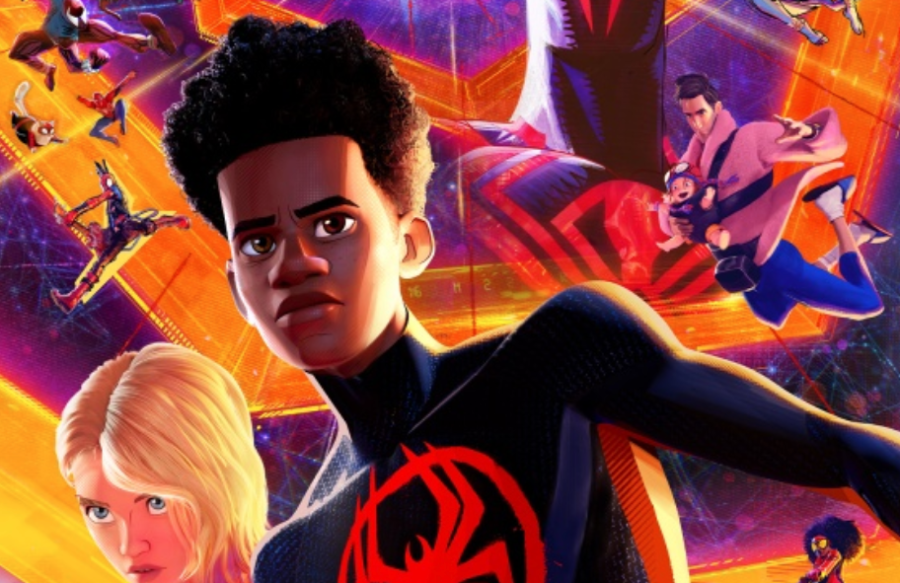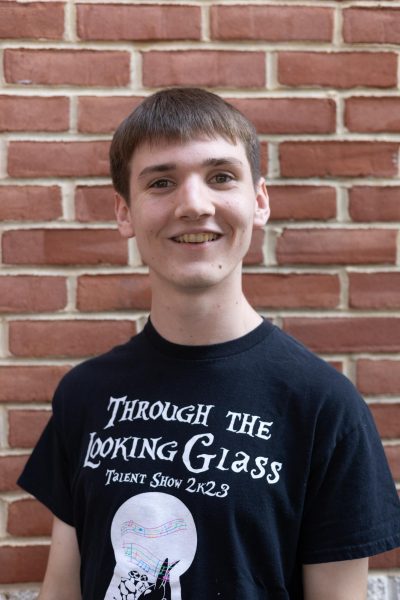“Spider-Man: Across the Spider-Verse”: An exhilarating thrill-ride of the web-slinger’s best
“Spider-Man: Across the Spider-Verse” manages to succeed as a Spider-Man film while feeling refreshingly original and never overly derivative.
June 6, 2023
Arriving five years after 2018’s “Spider-Man: Into the Spider-Verse,” Sony’s newest animated Spider-Man film “Spider-Man: Across the Spider-Verse” swings onto screens with the same confidence and mastery as its predecessor. The highly anticipated sequel delivers all of the signature artistic sensibilities from the first film, with many new and improved artistic decisions. As the fan-favorite characters travel throughout the multiverse, it’s clear that the legacy of Spider-Man is more alive now than ever.
“Across the Spider-Verse” features Miles Morales (Shameik Moore) returning as the main character, paired with Gwen Stacy (Hailee Steinfeld) who takes a more prominent role in the story.
The opening sequence features Gwen’s home world, a beautiful canvas that bleeds with watercolor, similar to the original comic artwork. This art style contrasts with Miles’ home, establishing a unique world that more than quenches fans’ thirst for new universes to indulge in. But the opening 15 minutes isn’t just another opportunity to display the artwork — it introduces viewers to Gwen’s backstory, giving her character more depth and setting up the familiar tropes of the superhero archetype that is challenged later.
Even the initial plot points of the movie open from her specific point of view, as she’s recruited by an elite task force of alternate universe Spider-People, led by the futuristic Spider-Man 2099 (Oscar Isaac), who are trying to stop anomalies from disrupting the multiverse.
The potential cliché setup is subverted by a distinct focus on character-driven stakes and a constant refutation of genre tropes. As the film shifts focus to Miles — who is taller and more powerful than audiences left him in “Into the Spider-Verse” — audiences are given ample time to spend with him as he struggles to balance his superhero duties with his personal life.
The movie’s ability to slowly build key plot threads without rushing into climaxes is a luxury afforded by its status as the second movie in a trilogy. Despite initially having a more laid-back vibe, the movie maintains an electric flow through its fluid animation, amplified by the burgeoning heart and personality packed into every frame.
Right from the get-go, the film’s inventiveness and style push animation to its limits, throwing a dizzying flurry of colors and shapes that never let up for a second. Watching the interactions between the different Spider variants never becomes grating, and the way that each character retains their distinct animation style feels more revolutionary than ever. The design sensibilities that should clash in theory somehow mesh in strange and unique ways, as characters ebb and flow between the backgrounds in captivating collages of imagery.
The rapid-fire elegance of action is also the perfect fit for Spider-Man’s newest villain, The Spot (Jason Schwartzman) whose abilities to create warp-holes provide for some truly fun skirmishes between him and the Spider-People. As The Spot’s powers continue to grow, he gains control over other universes, leading Miles to work with 2099’s team to try to take him down.
Along the way, Miles meets a slew of new multiversal counterparts, like the impressively put-together Spider-Man India (Karan Soni) and the explosive anti-fascist rocker Spider-Punk (Daniel Kaluuya) alongside the returning Peter B. Parker (Jake Johnson) and countless other fan-favorite cameos. Although learning about the huge network of Spider-People is more than thrilling, it’s a shame that The Spot gets somewhat lost in the shuffle, considering the lengths taken to present him as a threatening villain. While the next installment leaves plenty of room for The Spot to shine, it’s hard to see if that will be the case after witnessing the sheer number of plot threads and cliffhangers set up at the end.
Directors Joaquim Dos Santos, Kemp Powers and Justin K Thompson, alongside producers and writers Phil Lord and Christopher Miller, chose to double down on the elements that made “Into the Spider-Verse” so special. What “Across the Spider-Verse” lacks in simplicity, it more than makes up for in its commitment to innovation, animation and storytelling.
On the whole, the movie is a celebration of everything that Spider-Man stories and characters have accomplished in their 60+ years of history. It succeeds as a Spider-Man film while feeling refreshingly original and never overly derivative. Very few elements of the two live-action Spider-Man movies released since “Into the Spider-Verse” can compare to the sheer beauty on display in “Across the Spider-Verse,” with each frame imbued with limitless passion and creativity. It’s hard to conceive of a project that could be so reverential to the legacy of Marvel comics’ Spider-Man while positioning a counter to the overdone tropes of the character.
It’s in the nature of a two-part film to feel a little incomplete, as it’s only half of a larger whole. What sets this particular ending apart, however, is the way that the film’s comic DNA taps into the crossover storytelling that’s often integral to superhero comics. Towards the end of the film, as the twists and turns intensify and the next issue of Miles’ Spider-Man comic lands on the table, it truly feels like the turning point in a larger story. The ending isn’t jarring or abrupt, and the way it keeps piling on twists and reveals reminds audiences that the next issue of the comic is just waiting to be picked up.
“Spider-Man: Across the Spider-Verse” is the kind of movie that makes you want to drive out to your local comic book store, pick up the latest Spidey-related issue and revel in the artistic possibilities of these characters and concepts. If “Spider-Man: Beyond the Spider-Verse” ends up being just as special as this film was, the Spider-Verse trilogy will only further cement itself as one of the finest examples of modern comic-book and superhero filmmaking on this side of the multiverse.










Sam L • Jun 7, 2023 at 11:03 am
Heat!